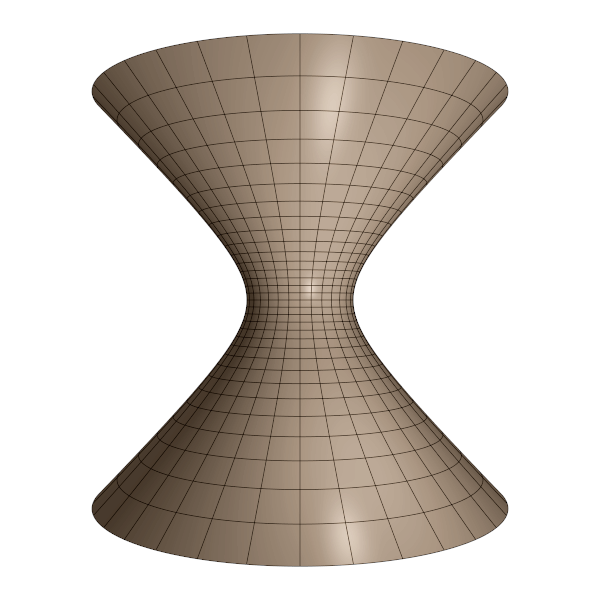Ellipse
Object type: Plane curve
Definition
In $\mathbb{R}^2$, an ellipse $E$ is a set of points $(x, y)$ satisfying the equation $$\left(\frac{x}{a}\right)^2 + \left(\frac{y}{b}\right)^2 = 1$$ for some $a, b > 0$. If $a = b =: r$, then the curve is a circle of radius $r$. Assuming $a > b$, the quantities $a$ and $b$ are called the semimajor and semiminor axis length, respectively. The $x$ and $y$ axes are called the major and minor axes of the ellipse. If $a < b$, the names are reversed accordingly. From now on, we will assume that $x$ is the major axis (that is, $a > b$). In the figure below, $a = 2$ and $b = 1$.
The area enclosed by the ellipse is $A = a b \pi$.
Parameterisations
This ellipse is a closed curve contained in the rectangle $\left[-a, a\right]\times \left[-b, b\right]$. It can be parameterised by the trigonometric functions. Indeed, the ellipse is the image $E = \mathbf{r}\left(\left[0, 2\pi\right[\right)$ where $$\mathbf{r} \left(t\right) = \underline{\mathbf{e}} \begin{pmatrix}a \cos{t} \\ b \sin{t}\end{pmatrix}, \quad\quad \forall t \in \left[0, 2\pi\right[,$$ as is evident from their definition using the unit circle. In addition, any point $\mathbf{r}\left(t\right)$ clearly satisfies the defining equation of an ellipse because of the trigonometric identity $\sin^2 {t} + \cos^2 {t} = 1$.
The defining equation of the ellipse is equivalent to $y = \pm b\sqrt{1 - x^2/a^2}$. Hence, the upper part ($y \ge 0$) of the ellipse can also be parameterised using $x \in \left[ -a, a\right]$ as parameter by putting $y = b\sqrt{1 - {x^2}/{a^2}}$, or, more explicitly, $$\mathbf{r}\left(t\right) = \underline{\mathbf{e}} \begin{pmatrix}t \\ b\sqrt{1 - {t^2}/ {a^2}}\end{pmatrix}, \quad\quad \forall t \in \left[-a, a\right].$$ In other words, the upper part is the graph of the function $x \mapsto b\sqrt{1 - {x^2}/{a^2}}$. The lower part of the ellipse can be parameterised by putting $y = -b\sqrt{1 - {x^2}/{a^2}}$.
Curvature
Using the standard (trigonometric) parameterisation, the curvature function for the ellipse is $$\kappa(t) = \frac{ab}{\left(a^2 \sin^2 {t} + b^2 \cos^2 {t}\right)^{3/2}}.$$ In particular, the curvature of a circle of radius $r := a = b$ is $\kappa = 1/r$.
Eccentricity and Foci
The eccentricity $\epsilon \in \left[0, 1\right[$ of the ellipse is defined as $$\epsilon = \sqrt{1−\frac{b^2}{a^2}}$$ and is (roughly) a measure of the how much a circle needs to be 'flattened' in order to conincide with the ellipse. Indeed, in the case of a circle, $a = b$ and so $\epsilon = 0$; on the other hand, if $a \gg b$, then $b/a \approx 0$ and so $\epsilon \approx 1$.
The two points $$F_1 = -\sqrt{a^2 − b^2} \mathbf{\hat{x}}$$ and $$F_2 = +\sqrt{a^2 − b^2} \mathbf{\hat{x}}$$ are called the foci of the ellipse. Notice that $F_1$ and $F_2$ both lie on the major axis, that $F_1 = -F_2$, and that $|F_1| = |F_2| = \sqrt{a^2−b^2} = a \sqrt{1 − b^2/a^2} = a \epsilon < a$, displaying the fact that both foci lie inside the ellipse. It is straightforward to prove that $$|P − F_1| + |F_2 − P| = 2a \quad \Leftrightarrow \quad P \in E.$$
A corollary of this result is a very easy way of drawing an ellipse using pen and paper. Fix two points on the paper – these will become the foci of the ellipse – and stick two drawing pins at these points. Then attach the ends of a string of length $2a$ to these pins, and hold a pencil against the string in such a way that the string is always fully extended. The curve drawn by the pen as the pen takes all possible positions is an ellipse of semi-major axis $a$.
The distance between any of the foci and the ellipse as measured along a line parallel to the minor axis is called the semi-latus rectum of the ellipse. It is readily verified that the semi-latus rectum is $a(1 - \epsilon^2)$.
Polar Equation
The polar equation of an ellipse with semi-major axis along the $\varphi = 0$ axis and the right-most focus at the origin is $$r = \frac{a(1-\epsilon^2)}{1 + \epsilon \cos{\varphi}}.$$ We remark that the numerator is the semi-latus rectum of the ellipse.
Examples
According to Kepler's first law of planetary motion, the orbit of every planet in the solar system is an ellipse with the sun at one of the foci. In fact, in any physical system in which the net force is given by an inverse-square law, the closed orbits are ellipses.
